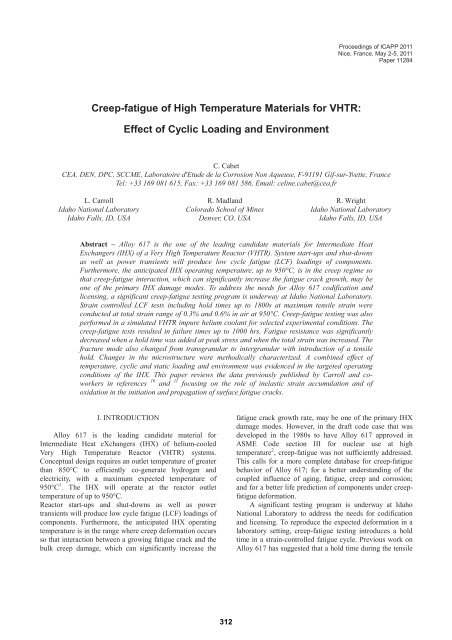Creep-fatigue of High Temperature Materials for VHTR: Effect of ...
Creep-fatigue of High Temperature Materials for VHTR: Effect of ...
Creep-fatigue of High Temperature Materials for VHTR: Effect of ...
Create successful ePaper yourself
Turn your PDF publications into a flip-book with our unique Google optimized e-Paper software.
<strong>Creep</strong>-<strong>fatigue</strong> <strong>of</strong> <strong>High</strong> <strong>Temperature</strong> <strong>Materials</strong> <strong>for</strong> <strong>VHTR</strong>:<br />
<strong>Effect</strong> <strong>of</strong> Cyclic Loading and Environment<br />
Proceedings <strong>of</strong> ICAPP 2011<br />
Nice, France, May 2-5, 2011<br />
Paper 11284<br />
C. Cabet<br />
CEA, DEN, DPC, SCCME, Laboratoire d'Etude de la Corrosion Non Aqueuse, F-91191 Gif-sur-Yvette, France<br />
Tel: +33 169 081 615, Fax: +33 169 081 586, Email: celine.cabet@cea.fr<br />
L. Carroll<br />
Idaho National Laboratory<br />
Idaho Falls, ID, USA<br />
R. Madland<br />
Colorado School <strong>of</strong> Mines<br />
Denver, CO, USA<br />
R. Wright<br />
Idaho National Laboratory<br />
Idaho Falls, ID, USA<br />
Abstract – Alloy 617 is the one <strong>of</strong> the leading candidate materials <strong>for</strong> Intermediate Heat<br />
Exchangers (IHX) <strong>of</strong> a Very <strong>High</strong> <strong>Temperature</strong> Reactor (<strong>VHTR</strong>). System start-ups and shut-downs<br />
as well as power transients will produce low cycle <strong>fatigue</strong> (LCF) loadings <strong>of</strong> components.<br />
Furthermore, the anticipated IHX operating temperature, up to 950°C, is in the creep regime so<br />
that creep-<strong>fatigue</strong> interaction, which can significantly increase the <strong>fatigue</strong> crack growth, may be<br />
one <strong>of</strong> the primary IHX damage modes. To address the needs <strong>for</strong> Alloy 617 codification and<br />
licensing, a significant creep-<strong>fatigue</strong> testing program is underway at Idaho National Laboratory.<br />
Strain controlled LCF tests including hold times up to 1800s at maximum tensile strain were<br />
conducted at total strain range <strong>of</strong> 0.3% and 0.6% in air at 950°C. <strong>Creep</strong>-<strong>fatigue</strong> testing was also<br />
per<strong>for</strong>med in a simulated <strong>VHTR</strong> impure helium coolant <strong>for</strong> selected experimental conditions. The<br />
creep-<strong>fatigue</strong> tests resulted in failure times up to 1000 hrs. Fatigue resistance was significantly<br />
decreased when a hold time was added at peak stress and when the total strain was increased. The<br />
fracture mode also changed from transgranular to intergranular with introduction <strong>of</strong> a tensile<br />
hold. Changes in the microstructure were methodically characterized. A combined effect <strong>of</strong><br />
temperature, cyclic and static loading and environment was evidenced in the targeted operating<br />
conditions <strong>of</strong> the IHX. This paper reviews the data previously published by Carroll and coworkers<br />
in references 10 and 11 focusing on the role <strong>of</strong> inelastic strain accumulation and <strong>of</strong><br />
oxidation in the initiation and propagation <strong>of</strong> surface <strong>fatigue</strong> cracks.<br />
I. INTRODUCTION<br />
Alloy 617 is the leading candidate material <strong>for</strong><br />
Intermediate Heat eXchangers (IHX) <strong>of</strong> helium-cooled<br />
Very <strong>High</strong> <strong>Temperature</strong> Reactor (<strong>VHTR</strong>) systems.<br />
Conceptual design requires an outlet temperature <strong>of</strong> greater<br />
than 850°C to efficiently co-generate hydrogen and<br />
electricity, with a maximum expected temperature <strong>of</strong><br />
950°C 1 . The IHX will operate at the reactor outlet<br />
temperature <strong>of</strong> up to 950°C.<br />
Reactor start-ups and shut-downs as well as power<br />
transients will produce low cycle <strong>fatigue</strong> (LCF) loadings <strong>of</strong><br />
components. Furthermore, the anticipated IHX operating<br />
temperature is in the range where creep de<strong>for</strong>mation occurs<br />
so that interaction between a growing <strong>fatigue</strong> crack and the<br />
bulk creep damage, which can significantly increase the<br />
312<br />
<strong>fatigue</strong> crack growth rate, may be one <strong>of</strong> the primary IHX<br />
damage modes. However, in the draft code case that was<br />
developed in the 1980s to have Alloy 617 approved in<br />
ASME Code section III <strong>for</strong> nuclear use at high<br />
temperature 2 , creep-<strong>fatigue</strong> was not sufficiently addressed.<br />
This calls <strong>for</strong> a more complete database <strong>for</strong> creep-<strong>fatigue</strong><br />
behavior <strong>of</strong> Alloy 617; <strong>for</strong> a better understanding <strong>of</strong> the<br />
coupled influence <strong>of</strong> aging, <strong>fatigue</strong>, creep and corrosion;<br />
and <strong>for</strong> a better life prediction <strong>of</strong> components under creep<strong>fatigue</strong><br />
de<strong>for</strong>mation. �<br />
A significant testing program is underway at Idaho<br />
National Laboratory to address the needs <strong>for</strong> codification<br />
and licensing. To reproduce the expected de<strong>for</strong>mation in a<br />
laboratory setting, creep-<strong>fatigue</strong> testing introduces a hold<br />
time in a strain-controlled <strong>fatigue</strong> cycle. Previous work on<br />
Alloy 617 has suggested that a hold time during the tensile

















